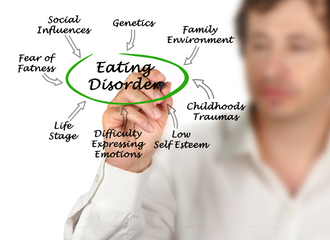Written by: Samantha DeCaro, PsyD (she/her)
Director of Clinical Outreach and Education, The Renfrew Center
If you or a loved one is in crisis, help is always available. Call the National Suicide Prevention Lifeline (Lifeline) at 1-800-273-TALK (8255), or text the Crisis Text Line (text HELLO to 741741). Both services are free and available 24 hours a day, seven days a week.

Eating disorders are the second deadliest mental health diagnoses in the DSM-5, and the risk of suicidality is significantly elevated not only for those who meet criteria for an eating disorder, but also for individuals who report body dissatisfaction and engage in subclinical disordered eating.
It is estimated that nearly half of individuals with eating disorders report suicidal ideation (Portzsky G., van Heeringen K., & Vervaet M., 2014).
In a 2019 national study of graduate and undergraduate college students, answering “Yes” on merely one question on the SCOFF eating disorder screening tool was linked to an elevated risk of suicidality. 1 In the eating disorder population, research suggests that risk is highest for those with anorexia, co-occurring mental health diagnoses, purging behaviors, marginalized identities, and/or poor body image.
As mental health and medical providers serving these clients, it is our responsibility to know the risk factors for suicidality, evaluate the level of risk, identify protective factors, increase safety, and ultimately promote continued recovery.
Identifying the Risk Factors for Suicidality
There are various factors that further elevate risk of suicidality for your eating disorder clients. Those who occupy marginalized identities (e.g., fat, BIPOC, LGBTQIA+, etc) seem to be at higher risk according to research, especially for those who have internalized harmful ideologies and stigmas. Risk seems to also be elevated for those diagnosed with anorexia, as well as any client who reports purging behaviors, recent drops in weight, body dysmorphia, and/or the belief that they are a burden to others. Co-morbid mental health diagnoses, such as an eating disorder that occurs alongside depression, anxiety and/or a substance use disorder, also seem to elevate risk.
Other general risk factors include prior suicide attempts or aborted attempts by the client or the client’s family members, history of self-harm behaviors, previous psychiatric diagnoses, recent discharges from hospitals or treatment providers, significant life stressors, inaccessible services, hopelessness, disconnection from others, access to lethal means, as well as emotional and physical pain.
Assessing Suicide Risk
It’s important to be aware that your clients with an eating disorder diagnosis are at elevated risk for suicidality, however many eating disorders go undetected and untreated in various settings due to stigma, lack of awareness, treatment inequities, and provider biases. Unfortunately, there are medical and mental health providers unwittingly treating clients for depression or anxiety, while missing, minimizing, or even praising eating disorder signs and symptoms. As part of your suicide prevention efforts, consider screening every client for eating disorder risk during intake. This can be accomplished easily and quickly by using the SCOFF questionnaire (Morgan, Reid and Lacey, 1999), which consists of 5 questions that can be posed by both professionals and non-professionals in either verbal or written form.
S: Do you make yourself Sick (induce vomiting) because you feel uncomfortably full?
C: Do you worry you have lost Control over how much you eat?
O: Have you recently lost more than 15 pounds in a 3-month period?
F: Do you believe yourself to be Fat when others say you are too thin?
F: Would you say that Food dominates your life?
If your client answers “YES” to 2 or more questions, your client is likely at risk for an eating disorder and further assessment is recommended by an eating disorder specialist. Be mindful that the SCOFF questionnaire is a self-report measure, which may not be effective with certain populations. It also does not inquire about over-exercise (or other purging methods), reveal weight history, or screen for every feeding and eating disorder in the DSM-5. A more thorough assessment might include the Eating Disorder Inventory (EDI-3), the Eating Disorder Examination Questionnaire (EDE-Q), and/or the Eating Disorder Diagnostic Scale (EDDS).
To assess specifically for suicidality, the Columbia Suicide Severity Rating Scale (C-SSRS) is a short, evidenced based screening tool that can be used in a variety of different settings to assess the severity of suicidal ideation and behavior in children, adolescents and adults. You do not need any prior mental health training or experience to ask the questions in the C-SSRS.
To download an existing version of the C-SSRS click here.
Although training is not required to administer the C-SSRS, it can be helpful. Free training can be found here: https://cssrs.columbia.edu/training/training-options/
The SAFE-T (Suicide Assesment Five-step Evalutation and Triage) is another helpful guide for professionals to use when assessing for suicide risk and implementing interventions. It was developed using the APA Practice Guidelines for the Assesment and Treatment of Patients with Suicidal Behaviors. It includes a stratification chart to assist providers as they make a clinical judgment about level of risk (i.e., low, moderate, or high).
As outlined on the SAFE-T card, always ask direct questions during an assessment, including very specific questions about the frequency, intensity, and duration of any suicidal ideation, thoughts, behaviors, plan, intent, access to firearms or access to other lethal means. These questions will provide you with crucial information about the current level of risk without any real danger of increasing that risk. Be aware that the warning signs might not always be verbal. For example, your client might start giving away treasured belongings, report changes in sleep, seem inexplicably calm after a period of agitation, or suddenly disconnect from their relationships. With your client’s consent, information may also come from collateral sources such as family, friends, and other healthcare providers.
Interventions for Clients with Elevated Suicide Risk
Therapeutic interventions should aim to reduce pain, instill hope, foster connection, and decrease the capacity to act on suicidal thoughts (Bolster et al., 2015). During the assessment process, you and your client will have clearly identified their internal and external protective factors. These are essentially the things in your client’s life that buffer them from acting on suicidal thoughts and urges. Identifying protective factors will help you and your client take inventory of what they already have, while also revealing what might be needed to further reduce risk.
For example, does your client have access to the services, structure, medication, support, and supervision they require for their eating disorder recovery, medical symptoms, and comorbid psychological issues? Do they have supportive family, friends, pets, or trusted treatment team providers? Do they belong to an eating disorder recovery group, faith group, AA, NA, or other support group? Do they have the skill set needed for problem solving, stress management, advocacy, distress tolerance, media literacy, anger management, boundaries, emotional regulation, or conflict resolution?
The information gathered in the assessment process will help inform treatment planning, case management needs, as well as the appropriate level of care for your client.
Treatment Settings and Crisis Planning
The appropriate level of care for your client is determined by a variety of factors including the severity of medical issues, eating disorder behaviors, comorbid diagnoses, and level of suicide risk. Treatment should be provided in the least restrictive environment possible that still provides safe and effective services for your client. For clients with a high risk of suicidality, admission to a crisis center or local ER is generally indicated unless something can be immediately done to significantly reduce risk and keep your client safe.
If your client’s risk level is low to moderate, admission to a local emergency center might still be necessary depending on certain factors, but in some cases, providers can collaborate with their client and develop a Crisis Plan for them to follow instead. A crisis plan usually includes a list of triggers, warning signs, ways to make the home a safer space, helpful coping skills and distractions, phone numbers of treatment providers, 24-hour hotlines (e.g., The National Suicide Prevention Hotline: 1-800-273-TALK), crisis text lines (e.g., texting “NEDA” to 741741), contact information for helpful people, and the addresses of the nearest crisis centers and emergency rooms.
The crisis plan can also include important information about your client for an emergency team to quickly reference, such as the client’s address, diagnoses, previous suicide attempts, and current medications. It is recommended that copies of the crisis plan are stored in accessible places, such as around the home, in the client’s wallet, and/or digitally in the client’s cell phone. Ideally, clients will consent to reviewing and distributing the crisis plan to their supports, so that various people know exactly what to do in the event of a mental health emergency.
Conclusion
Given that suicidal risk is elevated in the eating disorder population, suicide prevention efforts should include screening every client for an eating disorder. If a client endorses 2 or more questions on the SCOFF questionnaire, a qualified eating disorder assessor can recommend the appropriate level of care based on the severity of the eating disorder behaviors, medical status, and presence of suicidality.
Mental health and medical professionals who frequently work with eating disorders (or those who engage in disordered eating) should identify the factors that further elevate risk of suicidality, as well as assess (and routinely re-assess) the level of risk throughout the course of treatment using evidenced based tools. For clients who do not require emergency services for their suicidality, treatment planning should aim to identify, utilize, and expand upon each client’s protective factors, reduce risk with collaborative crisis planning, and instill hope that a brighter future is possible in eating disorder recovery.



